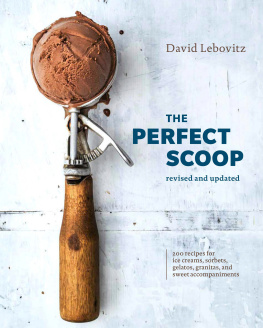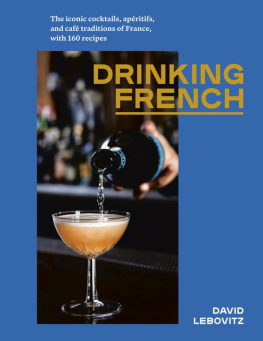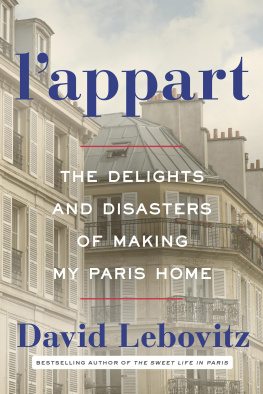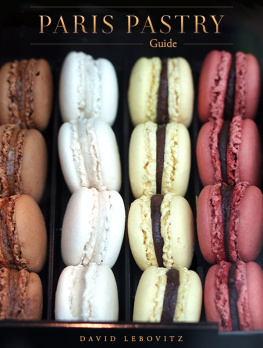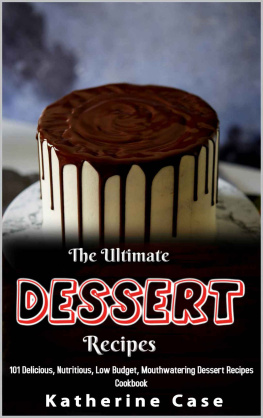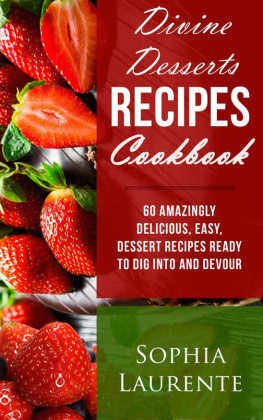David Lebovitz - Ready for Dessert: My Best Recipes
Here you can read online David Lebovitz - Ready for Dessert: My Best Recipes full text of the book (entire story) in english for free. Download pdf and epub, get meaning, cover and reviews about this ebook. year: 2010, publisher: Ten Speed Press, genre: Home and family. Description of the work, (preface) as well as reviews are available. Best literature library LitArk.com created for fans of good reading and offers a wide selection of genres:
Romance novel
Science fiction
Adventure
Detective
Science
History
Home and family
Prose
Art
Politics
Computer
Non-fiction
Religion
Business
Children
Humor
Choose a favorite category and find really read worthwhile books. Enjoy immersion in the world of imagination, feel the emotions of the characters or learn something new for yourself, make an fascinating discovery.

- Book:Ready for Dessert: My Best Recipes
- Author:
- Publisher:Ten Speed Press
- Genre:
- Year:2010
- Rating:3 / 5
- Favourites:Add to favourites
- Your mark:
- 60
- 1
- 2
- 3
- 4
- 5
Ready for Dessert: My Best Recipes: summary, description and annotation
We offer to read an annotation, description, summary or preface (depends on what the author of the book "Ready for Dessert: My Best Recipes" wrote himself). If you haven't found the necessary information about the book — write in the comments, we will try to find it.
Ready for Dessert: My Best Recipes — read online for free the complete book (whole text) full work
Below is the text of the book, divided by pages. System saving the place of the last page read, allows you to conveniently read the book "Ready for Dessert: My Best Recipes" online for free, without having to search again every time where you left off. Put a bookmark, and you can go to the page where you finished reading at any time.
Font size:
Interval:
Bookmark:

DAVID LEBOVITZ is a pastry chef, author, and creator of the award-winning food blog www.davidlebovitz.com. Trained as a baker in France and Belgium, he worked for twelve years in the pastry department at the famed Chez Panisse restaurant in Berkeley, California.
Room for Dessert, his first book, was an International Association of Culinary Professionals award nominee. He is also the author of The Sweet Life in Paris and The Perfect Scoop. David writes, blogs, and leads culinary tours from his home in Paris, France.
When people ask, How long did it take you to write this book? the answer for this particular one is Thirty years!
That may seem like a long time, but this book really was that long in the making, as its the culmination of years and years of baking professionally, and, subsequently, at home. Thankfully, Ive had some great help along the way.
Fritz Streiff provided his truly invaluable help on my first two books. I learned much of what I know about recipe writing from him, sitting side by side and taking breaks to run down to the kitchen to taste something just out of the oven.
Thanks to my agent Fred Hill and his associate Bonnie Nadell whove taken good care of meand brought me back home.
I loved working with Clancy Drake on a previous book and I couldnt have been happier to be paired up with her again. And Dawn Yanagihara came in at the eleventh hour and took on the enormous task of wrapping it all up, adding her very sharp eye and making sure I crossed the finish line.
When I was told that Maren Caruso was going to be taking the photographs, the word Great! couldnt come out of my mouth fast enough. I loved her work in other books and was thrilled when she signed on to shoot my desserts.
Thanks to Nancy Austin, for coming up with such a striking book design, and being such a pleasure to work with, once again. And to Susan Friedland, who did such a great job editing and guiding me through my first two books, which are generously borrowed from here.
Im incredibly fortunate to be part of a large and generous baking community. Ive been lucky to be able to count on Flo Braker, Marion Cunningham, Fran Gage, Emily Luchetti, Nick Malgieri, Alice Medrich, John Scharffenberger, Nancy Silverton, Kathleen Stewart, and Dede Wilson, for advice, encouragement, and a few recipes here and there along the way.
Virtual hugs to my online pals Matt Armendariz, Elise Bauer, Jesse Gardner, and Deb Perelman for keeping me sane.
Without the many, many people I worked with at Chez Panisse, I dont know where Id be. Mary Jo Thoresen, Mary Canales, Lisa Saltzman, Diane Wegner, Linda Zagula, and Shari Saunders were the best pastry buddies a guy could hope for. It was owner Alice Waters who told me to write my own book when I left the nest. Thanks most of all to Lindsey Shere who deserves a medal for putting up with me.
And to Romain Pellas, for going through yet another round.
Caramelization Guidelines
Caramel frequently shows up in my recipes because its one of my favorite flavors. Although its not difficult to caramelize sugar, if you havent done it before, the process can be intimidating, and it might take a couple of tries before youre comfortable taking it to the right degree of darkness: a deep amber liquid, on the edge of burnt, but still sweet in flavor.
When sugar is heated, it melts into liquid. As the sugar continues to cook, it begins to take on a bit of color, or caramelize. Because cookware and heat sources dont always distribute heat evenly, you need to stand guard during the entire process, encouraging the sugar to cook at an even rate.
The two things to watch out for when making caramel are recrystallizationwhat happens when sugar crystals join together in a lumpy massand burning the sugar. You can avoid recrystallization by making sure that the sugar is free of impurities and that the pan used to cook the caramel is clean. If youre making a wet caramelone that begins with sugar and water (more on that in a bit)limiting the amount that the mixture is stirred during cooking helps guard against recrystallization.
To avoid burning the caramel, its just a matter of being vigilant. The melted sugar should be cooked until its a deep amber colorits done when it starts to smoke and begins to foam just a little bit. At this point, it should be removed from the heat immediately to stop the sugar from darkening any further. Usually, a liquid is then quickly added, which also helps halt the cooking.
After making caramel, to clean the pan and dissolve any stuck-on bits, either soak it in warm water or fill the pan with water, bring it to a boil, and continue boiling until the caramel dissolves.
WET AND DRY CARAMEL
There are two kinds of caramel made in this book: wet and dry. A wet caramel is made by heating sugar and water together in the pan. Since wet caramel doesnt get too hard when cooled, I use it for sauces and to line ramekins for flan. A dry caramel is simply sugar heated without any liquid and can handle being stirred gently.
Wet Caramel
When making caramel, especially wet caramel, your main nemesis will be the sugars natural tendency to recrystallize. The sugar crystals have jagged edges and, even after liquefying, want to regroup into a solid mass. Stirring a wet caramel encourages these crystals to hook upand cause clumping.
One common technique for preventing recrystallization is to cook the sugar in a covered pot until the sugar is completely melted; the trapped condensation washes away crystals clinging to the side of the pot. Another is to use a clean brush dipped in water to wash down the sides, dissolving any crystals that may have formed. I dont recommend the latter technique as Ive lost a few bristles in the carameland found them later, when dessert was served. You can also add an interfering agent a tiny amount of cream of tartar or lemon juicenear the beginning of cooking to help inhibit recrystallization.
To make a wet caramel, begin by sprinkling the sugar in an even layer in a heavy-bottomed skillet or saucepan. Pour water over the sugar until is it completely and evenly moistenedyou dont want any dry spots. Cook the sugar and water over medium heat until the sugar dissolves. At this point, add a pinch of cream of tartar or a few drops of lemon juice, if indicated or desired. Continue cooking, watching carefully as the sugar begins to brown. If it starts to recrystallize, swirl the pan and continue to cook. Usually, the lumps will melt as the caramel continues to cook.
When the caramel has darkened to the point of being almost burntwhen its dark amber in color, smoking, and beginning to gently foamtake it off the heat and stop the cooking by pouring in the liquid called for in the recipe. Then stir or whisk the caramel over low heat until its smooth. If the lumps persist, you can always strain them out.
Dry Caramel
In some ways, making dry caramel is easier than making wet caramel, but it can be difficult to control the rate of caramelization because it happens much more quickly.
To make dry caramel, sprinkle an even layer of sugar in a heavy-bottomed skillet or saucepan. As you heat the sugar, the edges and bottom will melt first and start browning. With a heatproof utensil, gently push the liquefied sugar toward the center, which encourages the still-solid sugar to begin melting. Once the sugar begins to color, watch very closely because dry caramel cooks rapidly, so dont take your eyes off it until its the proper color. If the recipe calls for a liquid, add it now. Then stir or whisk the caramel over low heat until smooth. If there are any small bits of sugar remaining, you can strain the caramel to remove them.
Font size:
Interval:
Bookmark:
Similar books «Ready for Dessert: My Best Recipes»
Look at similar books to Ready for Dessert: My Best Recipes. We have selected literature similar in name and meaning in the hope of providing readers with more options to find new, interesting, not yet read works.
Discussion, reviews of the book Ready for Dessert: My Best Recipes and just readers' own opinions. Leave your comments, write what you think about the work, its meaning or the main characters. Specify what exactly you liked and what you didn't like, and why you think so.

